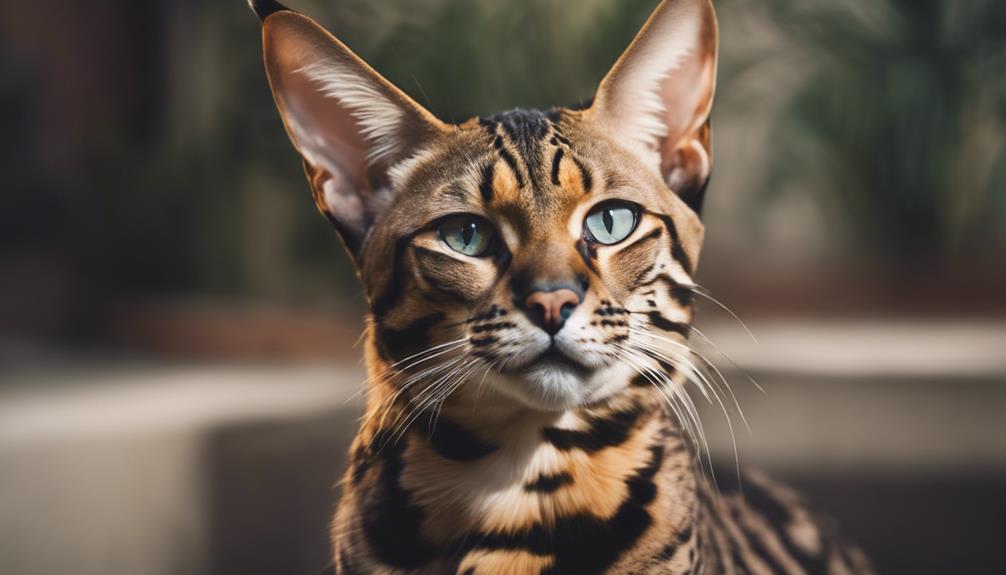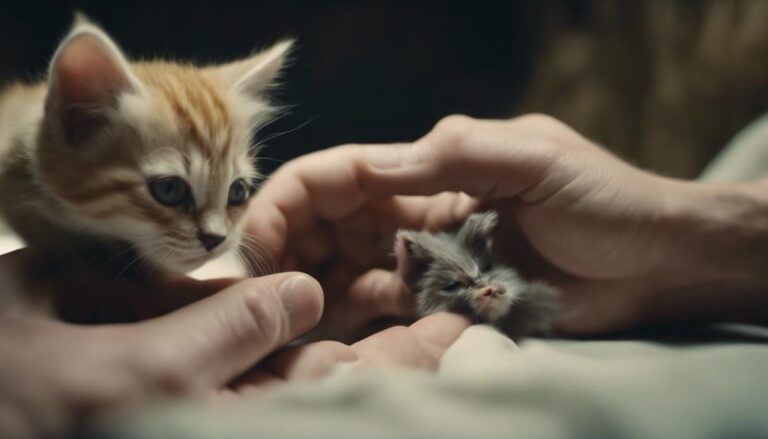When deciding between a Savannah and Bengal cat, you may find yourself intrigued by their contrasting traits and captivating allure. The Savannah's regal stature and friendly disposition stand in contrast to the Bengal's muscular build and independent streak. However, the choice goes beyond mere appearances. As you explore the nuances of their personalities, physical features, and care needs, you'll uncover a wealth of considerations that can influence which of these majestic felines would make the ideal companion for you.
History and Origin
The creation of Savannah and Bengal Cats involved crossbreeding domestic cats with wild feline species to achieve distinct appearances and characteristics. Savannah Cats were first bred in 1986 by Judee Frank, who crossed a domestic cat with a serval. They're known for their unique personality traits and striking appearance. The first Savannah Cat was named after the kitten Savannah.
On the other hand, Bengal Cats were developed by Jean Sugden in the 1960s by crossing a domestic cat with an Asian leopard cat. The primary goal was to create a domestic cat with a wild appearance similar to that of a wildcat. Both Savannah and Bengal Cats are considered hybrid breeds, combining the qualities of domestic and wild felines.
These cats have captivated many with their exotic looks and fascinating behaviors, making them popular choices for those seeking a touch of the wild in a domestic setting.
Physical Characteristics
When comparing Savannah and Bengal cats, you'll notice differences in their size and build, coat patterns, and facial features.
Savannah cats are generally larger and taller with a slender build and distinctively large ears, while Bengal cats are medium-sized with a muscular build and rounded ears.
Additionally, Savannah cats sport a spotted coat in colors like golden and silver, whereas Bengal cats showcase marbled or spotted patterns in shades of brown, silver, and snow.
Size and Build
With their larger size and distinct build, Savannah cats stand out when compared to Bengal cats in terms of physical characteristics. Savannah cats are generally taller and heavier, with males weighing between 12-25 pounds, while Bengals have a medium to large build, typically weighing between 8-15 pounds.
Savannah cats have a long, lean build with long legs, giving them an elegant appearance. In contrast, Bengals are muscular with sturdy legs, known for their agility and climbing skills. The slender build and long legs of Savannah cats make them graceful and striking, while Bengals showcase athleticism and strength.
These differences in size and build contribute to the unique charm of each breed.
Coat Patterns
Boasting distinctive coat patterns, both Savannah and Bengal cats exhibit unique markings that reflect their wild ancestry. Savannah cats typically sport a spotted coat ranging from golden to silver and black, resembling a wildcat's markings. On the other hand, Bengal cats showcase marbled or spotted coat patterns in colors like brown, silver, and snow.
Bengals often display rosettes or spots that mimic a leopard's coat. These coat patterns are inherited from their exotic heritage and wild ancestors, adding to their allure and charm. Whether you prefer the striking spots of the Savannah or the mesmerizing rosettes of the Bengal, both breeds showcase stunning coat patterns that pay homage to their wild roots.
Facial Features
The distinct facial features of Savannah and Bengal Cats showcase a blend of domestic and wildcat characteristics, embodying their hybrid origins. Savannah Cats are recognized for their large, tall ears and hooded eyes, contributing to their exotic appearance. In contrast, Bengal Cats have wide-set, rounded ears and unique rosettes resembling a leopard's spots.
Savannah Cats exhibit bold spots akin to a cheetah's coat pattern on their sleek bodies. Bengals are known for their muscular builds and medium size, enhancing their wild appearance. Both breeds' facial features reflect their hybrid lineage, combining elements of domestic and wildcat traits to create striking and unique appearances that set them apart in the feline world.
Personality Traits
Savannah and Bengal cats differ in their personality traits and energy levels.
Savannah cats are known for their sociable and extroverted nature, seeking human attention and displaying a dog-like loyalty.
On the other hand, Bengals can be more independent and self-entertaining, with a tendency towards shyness and timidity.
Temperament Differences
When comparing the temperament differences between Savannah Cats and Bengals, one notable contrast is their levels of independence and sociability.
- Savannah Cats are known for their dog-like loyalty, seeking human attention, and showing intense affection through interactive play.
- Bengals, on the other hand, can be more independent and shy, but they still form deep connections with their human families due to their expressive nature.
- Savannah Cats are described as curious, intelligent, and social with visitors, showcasing their outgoing and sociable personalities.
Understanding these distinctions can help you choose the feline companion whose temperament aligns best with your lifestyle and preferences.
Energy Levels
Comparing the energy levels between Savannah Cats and Bengals reveals their lively and inquisitive personalities that require engaging activities to thrive. Both Bengal and Savannah cats are known for their high energy levels, intelligence, and curiosity.
Savannah Cats, being hybrid breeds with a wild serval ancestor, exhibit dog-like loyalty and seek interactive play with their human companions.
Bengals, on the other hand, are energetic and playful, often displaying a penchant for climbing and exploring their environment.
To keep these breeds happy and healthy, mental stimulation and physical exercise are essential. Failing to provide adequate outlets for their energy can lead to boredom and potential behavioral issues. Therefore, interactive play and activities that challenge their intellect are crucial for these lively felines.
Health and Lifespan
Why do Savannah and Bengal cats differ in their health and lifespan? When considering the health and lifespan of these domestic breeds, there are some key factors to take into account:
- Lifespan: Savannah cats generally live longer, with a lifespan ranging from 12 to 20 years, compared to Bengal cats, which typically live between 12 to 16 years.
- Health Issues: Savannah cats may be prone to hypertrophic cardiomyopathy, a heart condition, while Bengals could face progressive retinal atrophy and kidney problems, impacting their overall well-being.
- Importance of Maintenance: Regular vet check-ups and a balanced diet play a crucial role in safeguarding the health of both Savannah and Bengal cats. Ensuring they receive proper care and attention can contribute significantly to their longevity and quality of life.
Care and Maintenance
To ensure the well-being of Savannah and Bengal cats, proper care and maintenance are essential aspects to prioritize in their daily routines. Savannah Cats require daily exercise and playtime to meet their high energy levels, while Bengals need mental stimulation and interactive toys for their daily exercise needs.
Providing a large, secure outdoor enclosure or a cat-proofed indoor space is crucial for Savannah Cats to roam and explore safely. Bengals benefit from climbing structures and puzzle feeders that offer mental engagement and physical activity.
Regular grooming is essential for Savannah Cats to keep their coat healthy, whereas Bengals require weekly brushing to maintain their sleek appearance. Incorporating interactive toys and activities that challenge their intelligence will help both breeds thrive.
Remember to create a stimulating environment with climbing opportunities and secure outdoor spaces to cater to the care requirements of Savannah and Bengal cats.
Legal Considerations
Legal requirements for owning Bengal and Savannah cats differ based on their ancestry and hybrid generation. When considering these exotic breeds, it's crucial to be aware of the ownership regulations surrounding them.
- Hybrid Generation Classification: Understanding the hybrid generation of your Bengal or Savannah cat is essential to comply with legal requirements and breeding regulations.
- TICA Standards: The International Cat Association (TICA) sets standards for these breeds, emphasizing ethical considerations and responsible pet ownership.
- Legal Implications: Being informed about the legal implications of owning Bengals and Savannahs is crucial to ensure that you meet all necessary legal requirements and contribute to the responsible breeding and ownership of these unique feline companions.
Frequently Asked Questions
What Is the Difference Between a Bengal and a Savannah Cat?
When distinguishing between a Bengal and a Savannah cat, note that Bengal cats have rosettes resembling leopards and are more likely to be lap cats. Savannah cats, with cheetah-like spots, form close bonds with select individuals and display head-butting as affection.
What Cat Is Bigger Than Bengal Cat?
If you're wondering which cat is bigger than a Bengal cat, the Savannah cat takes the lead. With their taller, sleeker build and potential for greater weight, Savannah cats often outweigh their Bengal counterparts.
How Much Does a Savannah Bengal Cat Cost?
Savannah Bengal cat prices vary widely, ranging from $1,000 to $20,000 for Savannahs based on lineage and quality. Bengal kittens typically cost $400 to $10,000. Prices fluctuate due to breeder reputation, demand, and specific traits.
What Is the Difference Between a Serval Cat and a Bengal Cat?
When comparing a Serval cat to a Bengal cat, note that the former is a wild African species with distinctive features, while the latter is a hybrid breed known for its unique coat patterns and domestic temperament.






